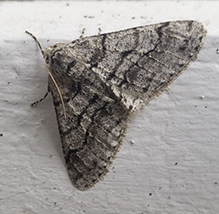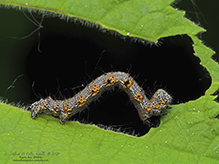Sources
Biodiversity occurrence data published by: Minnesota Biodiversity Atlas (accessed through the Minnesota Biodiversity Atlas Portal, bellatlas.umn.edu. Accessed 12/25/2025).
(Phigalia titea)
Conservation • Description • Habitat • Ecology • Distribution • Taxonomy

6658
not listed
NNR - Unranked
SNR - Unranked
not listed
Half-wing is a medium-sized, early season, typical geometer moth. It occurs in the United States and southern Canada east of the Great Plains. Adults are are among the first moths to be seen flying in early spring. They are found from late March to late May in forests and woodlands. Larvae feed on young leaves of trees, including American basswood, American elm, apple, birch, hickory, maple, oak, and poplar; and on woody shrubs, including blueberry, cranberry, and ninebark. They can defoliate small areas of a forest, and are considered a pest. However, they do not occur in numbers large enough to do serious damage.
The antennae have 46 to 48 segments. On the male they are feather-like with two branches on each segment (bipectinate). On the female they are thread-like.
The abdomen is slender. The upper surface is covered with flattened, elongated, deeply forked, hair-like scales.
Adult males have large wings in comparison to their light-weight bodies. The forewing length is ⅝″ to ⅞″ (15 to 22 mm) and the wingspan is 1 3⁄16″ to 1 9⁄16″ (30 to 40 mm). Most males have pale gray forewings with heavy, gray, grayish-brown, or brownish-black (dark) lines and a variable peppering of dark scales. There is no discal spot. The antemedial (AM) line is wavy and is shadowed by a broad dark basal band. The median line is broad and straight. The postmedial (PM) line is wavy, slightly scalloped or toothed, and shadowed with a broad dark band in the subterminal area. The PM line has a deep bend that approaches but does not touch the median line. The subterminal (ST) line is represented by a broken band of dark shading. The terminal line is thin. The fringe is the same color as the wing. The hindwing is similar to the forewing but lacks the dark bands and the median line is incomplete. Females do not fly. They have all four wings but they are very small and non-functional. The forewing length is just ⅛″ (3 to 4 mm).
The legs are pale gray or grayish-brown and are covered with a variable amount of scattered dark scales. The fourth segment (tibia) of the front leg does not have a spine at the tip. On the hind leg there are two pairs of spurs on the tibia.
A dark (melanistic) form is not uncommon. On these moths the base color of the wings is dark brown to almost black and the lines and veins are black.
The caterpillar, called spiny looper, is light bluish-gray and up to 1⅜″ (3.5 cm) long. It has numerous black pinstripes running the length of the body. There is an orange stripe bordered with thin black lines on each side close to the middle (addorsal). There is also an orange patch on each side of every abdominal segment around the breathing pore (spiracle). On the second, third, and eighth abdominal segments there is a raised ward below and behind each spiracle. Stiff, bristle-like hairs (setae) on the upperside of each abdominal segment rise from black pimple-like bases. The head has many small, scattered, black spots.
Male forewing length: ⅝″ to ⅞″ (15 to 22 mm)
Female forewing length: ⅛″ (3 to 4 mm)
Male wingspan: 1 3⁄16″ to 1 9⁄16″ (30 to 40 mm)
Forests and woodlands
One generation per year: Late March to late May.
The female deposits eggs in crevices in bark. When the eggs hatch, the caterpillar crawls or floats about on a silk thread (balloons) to find suitable foliage. Caterpillars feed for about a month and a half, passing through five stages (instars). They overwinter in the soil as pupa. Adults emerge from late May to late April.
American basswood, American elm, apple, birch, hickory, maple, oak, poplar, blueberry, cranberry, and ninebark.

Common
Order
Lepidoptera (Butterflies and Moths)
Superfamily
Geometroidea (Geometrid and Swallowtail Moths)
Family
Subfamily
Ennominae (Typical Geometers)
Tribe
Boarmiini
Genus
Phigalia
Tribe
The genus Phigalia was previously included in the tribe Bistonini. A recent phylogenomic analysis (Murillo-Ramos et al., 2019) has necessitated a significant taxonomic revision of the subfamily Ennominae (Typical Geometers). Under this framework, the tribe Boarmiini is massively expanded to include several formerly independent tribes, including Bistonini, to ensure the tribe is monophyletic, that it includes all descendents from its most recent common ancestor (or ancestral population) and no others.
This reordering has been adopted by major biodiversity databases including ITIS and iNaturalist. Some sources that rely on traditional checklists, including BugGuide.net, maintain a narrower definition of Boarmiini, and continue to include Phigalia in the tribe Bistonini.
Apocheima titea
Deileptenia titearia
Phalaena titea
Phigalia cinctaria
Phigalia deplorans
Phigalia mephistaria
Phigalia olivacearia mephistarua
Phigalia revocata
Phigalia titea
Rhaphidodemas nevadaria
half-wing
half-wing moth (adult)
spiny looper (caterpillar)
Glossary
Antemedial (AM) line
A thin line separating the basal area and the median area of the forewing of Lepidoptera.
Postmedial (PM) line
A thin line separating the median area and the postmedial area of the forewing of Lepidoptera.
Seta
A stiff, hair-like process on the outer surface of an organism. In Lepidoptera: A usually rigid bristle- or hair-like outgrowth used to sense touch. In mosses: The stalk supporting a spore-bearing capsule and supplying it with nutrients. Plural: setae. Adjective: setose.
Spiracle
A small opening on the surface of an insect or arachnid through which it breathes.
Tibia
The fourth segment of an insect leg, after the femur and before the tarsus (foot). The fifth segment of a spider leg or palp. Plural: tibiae.
Industrial melanism
The dark coloring on melanistic individuals is thought to be an adaptation to the color of the bark and lichens on the host plant. It may be an example of industrial melanism, where the insect evolves to match the soot-darkened bark of its host.
This button not working for you?
Simply email us at info@MinnesotaSeasons.com.
Attach one or more photos and, if you like, a caption.

Phigalia titea half-wing moth
Phigalia titea, half-wing moth, male, photographed on the house adjacent to Barnes Prairie, Racine Co., WI, on April 14, 2022.



This button not working for you?
Simply email us at info@MinnesotaSeasons.com.
Attach a video, a YouTube link, or a cloud storage link.
Carl Barrentine
Carl Barrentine
Carl Barrentine
Carl Barrentine
Carl Barrentine

This button not working for you?
Simply email us at info@MinnesotaSeasons.com.
Be sure to include a location.
4/14/2022
5/30 to 6/1/2021
